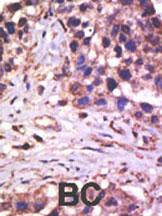USP5 Antibody (N-term)
Purified Rabbit Polyclonal Antibody (Pab)
- 产品详情
- 文献引用 : 1
- 实验流程
- 背景知识
Application
| WB, IHC-P, E |
|---|---|
| Primary Accession | P45974 |
| Reactivity | Human |
| Host | Rabbit |
| Clonality | Polyclonal |
| Isotype | Rabbit IgG |
| Calculated MW | 95786 Da |
| Antigen Region | 59-90 aa |
| Gene ID | 8078 |
|---|---|
| Other Names | Ubiquitin carboxyl-terminal hydrolase 5, Deubiquitinating enzyme 5, Isopeptidase T, Ubiquitin thioesterase 5, Ubiquitin-specific-processing protease 5, USP5, ISOT |
| Target/Specificity | This USP5 antibody is generated from rabbits immunized with a KLH conjugated synthetic peptide between 59-90 amino acids from the N-terminal region of human USP5. |
| Dilution | WB~~1:1000 IHC-P~~1:100~500 E~~Use at an assay dependent concentration. |
| Format | Purified polyclonal antibody supplied in PBS with 0.09% (W/V) sodium azide. This antibody is prepared by Saturated Ammonium Sulfate (SAS) precipitation followed by dialysis against PBS. |
| Storage | Maintain refrigerated at 2-8°C for up to 2 weeks. For long term storage store at -20°C in small aliquots to prevent freeze-thaw cycles. |
| Precautions | USP5 Antibody (N-term) is for research use only and not for use in diagnostic or therapeutic procedures. |
| Name | USP5 |
|---|---|
| Synonyms | ISOT |
| Function | Deubiquitinating enzyme that participates in a wide range of cellular processes by specifically cleaving isopeptide bonds between ubiquitin and substrate proteins or ubiquitin itself. Affects thereby important cellular signaling pathways such as NF-kappa-B, Wnt/beta- catenin, and cytokine production by regulating ubiquitin-dependent protein degradation. Participates in the activation of the Wnt signaling pathway by promoting FOXM1 deubiquitination and stabilization that induces the recruitment of beta-catenin to Wnt target gene promoter (PubMed:26912724). Regulates the assembly and disassembly of heat-induced stress granules by mediating the hydrolysis of unanchored ubiquitin chains (PubMed:29567855). Promotes lipopolysaccharide-induced apoptosis and inflammatory response by stabilizing the TXNIP protein (PubMed:37534934). Affects T-cell biology by stabilizing the inhibitory receptor on T-cells PDC1 (PubMed:37208329). Acts as a negative regulator of autophagy by regulating ULK1 at both protein and mRNA levels (PubMed:37607937). Acts also as a negative regulator of type I interferon production by simultaneously removing both 'Lys-48'-linked unanchored and 'Lys-63'-linked anchored polyubiquitin chains on the transcription factor IRF3 (PubMed:39761299). Modulates the stability of DNA mismatch repair protein MLH1 and counteracts the effect of the ubiquitin ligase UBR4 (PubMed:39032648). Upon activation by insulin, it gets phosphorylated through mTORC1-mediated phosphorylation to enhance YTHDF1 stability by removing 'Lys-11'-linked polyubiquitination (PubMed:39900921). May also deubiquitinate other substrates such as the calcium channel CACNA1H (By similarity). |
| Cellular Location | Cytoplasm. Cytoplasm, Stress granule. Nucleus |
For Research Use Only. Not For Use In Diagnostic Procedures.

Provided below are standard protocols that you may find useful for product applications.
BACKGROUND
Modification of target proteins by ubiquitin participates in a wide array of biological functions. Proteins destined for degradation or processing via the 26 S proteasome are coupled to multiple copies of ubiquitin. However, attachment of ubiquitin or ubiquitin-related molecules may also result in changes in subcellular distribution or modification of protein activity. An additional level of ubiquitin regulation, deubiquitination, is catalyzed by proteases called deubiquitinating enzymes, which fall into four distinct families. Ubiquitin C-terminal hydrolases, ubiquitin-specific processing proteases (USPs),1 OTU-domain ubiquitin-aldehyde-binding proteins, and Jab1/Pad1/MPN-domain-containing metallo-enzymes. Among these four families, USPs represent the most widespread and represented deubiquitinating enzymes across evolution. USPs tend to release ubiquitin from a conjugated protein. They display similar catalytic domains containing conserved Cys and His boxes but divergent N-terminal and occasionally C-terminal extensions, which are thought to function in substrate recognition, subcellular localization, and protein-protein interactions.
REFERENCES
Strausberg, R.L., et al., Proc. Natl. Acad. Sci. U.S.A. 99(26):16899-16903 (2002).
Ansari-Lari, M.A., et al., Genome Res. 6(4):314-326 (1996).
Falquet, L., et al., FEBS Lett. 376(3):233-237 (1995).
Falquet, L., et al., FEBS Lett. 359(1):73-77 (1995).
终于等到您。ABCEPTA(百远生物)抗体产品。
点击下方“我要评价 ”按钮提交您的反馈信息,您的反馈和评价是我们最宝贵的财富之一,
我们将在1-3个工作日内处理您的反馈信息。
如有疑问,联系:0512-88856768 tech-china@abcepta.com.






















 癌症的基本特征包括细胞增殖、血管生成、迁移、凋亡逃避机制和细胞永生等。找到癌症发生过程中这些通路的关键标记物和对应的抗体用于检测至关重要。
癌症的基本特征包括细胞增殖、血管生成、迁移、凋亡逃避机制和细胞永生等。找到癌症发生过程中这些通路的关键标记物和对应的抗体用于检测至关重要。 为您推荐一个泛素化位点预测神器——泛素化分析工具,可以为您的蛋白的泛素化位点作出预测和评分。
为您推荐一个泛素化位点预测神器——泛素化分析工具,可以为您的蛋白的泛素化位点作出预测和评分。 细胞自噬受体图形绘图工具为你的蛋白的细胞受体结合位点作出预测和评分,识别结合到自噬通路中的蛋白是非常重要的,便于让我们理解自噬在正常生理、病理过程中的作用,如发育、细胞分化、神经退化性疾病、压力条件下、感染和癌症。
细胞自噬受体图形绘图工具为你的蛋白的细胞受体结合位点作出预测和评分,识别结合到自噬通路中的蛋白是非常重要的,便于让我们理解自噬在正常生理、病理过程中的作用,如发育、细胞分化、神经退化性疾病、压力条件下、感染和癌症。







